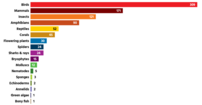
Watching birds is tremendously popular, especially in the USA and Europe, but also worldwide. The published literature on birds is impressive, with scientific research increasing, including through bird-ringing programmes and population surveys. BirdLife’s World Bird Database manages extensive information on threatened bird species and Important Bird and Biodiversity Areas (IBAs, Key Biodiversity Areas identified for birds).

Watching birds is tremendously popular. For example, c. 45.1 million people in the United States (around one in five) spend time observing and identifying birds (USFWS & U.S. Census Bureau 2016), and 20 million people (around one in three) in the United Kingdom are birdwatchers or regularly feed birds in their gardens (www.fatbirder.com). In 2019, more than 28,000 people participated in BirdLife’s annual EuroBirdwatch, with 1,089 events held across 35 European countries and more than 4.2 million bird sightings logged.
Scientific research on birds is intensive, and increasing. A “Web of Science” keyword search reveals that during 2010–2020, over 75,000 articles were published in academic journals with the word “bird” in the title or abstract—an increase of more than 70% since the previous decade. Of these, 3,087—an average of six articles per week—focused specifically on biodiversity conservation. Many birdwatchers are skilled observers, and are able to contribute high quality data. Information on breeding and non-breeding bird distribution, migration, ecology and behaviour is collected from all over the world, through the hard work of thousands of individuals and organisations. For example, over 140 million bird sightings were entered into the eBird system in 2019 alone, including a record-breaking day on 4 May when 35,000 birders collectively noted 6,955 species of birds across 174 countries. In many countries, data on migration and longevity are gathered through extensive bird-ringing programmes. In the UK alone over 900,000 birds are ringed each year (www.bto.org). Population surveys such as the Breeding Bird Survey (BBS) of North America provide up-to-date information on bird populations and trends: over 5,000 routes are surveyed annually, each with 50 counts (Sauer et al. 2011).
Popular interest in birds is reflected in the sheer volume of articles, field guides and other books that have been published about them. In 2004, the largest natural history book distributor was marketing 3.5 times more books about birds than about mammals. There are guides to bird identification covering the entire globe, with individual guides produced for the majority of countries, and many others that focus on particular groups of birds. A literature survey of the birdlife of Australasia and Oceania alone reveals over 4,600 books and reports (Simpson 1995).
This huge array of information is also being brought together in a meaningful way for conservation. BirdLife International is the official IUCN Red List Authority for birds, using data from a wide range of sources to assess the extinction risk of the world’s birds. BirdLife’s World Bird Database (WBDB), initiated in 1994, manages extensive information on over 11,000 species (including 1,481 threatened bird species), over 13,000 Important Bird Areas (IBAs) and 363 Endemic Bird Areas (EBAs).
References
Sauer, J. R., Hines, J. E., Fallon, J. E., Pardieck, K. L., Ziolkowski, D. J. and Link, W. A. (2011) The North American Breeding Bird Survey results and analysis 1966-2009. Version 3.23.2011 Laurel, Maryland: Patuxent Wildlife Research Center.
Simpson (1995) The Bird-book Book. Melbourne: Natural Learning Pty Limited.
USFWS & U.S. Census Bureau (2016). National Survey of Fishing, Hunting, and Wildlife-Associated Recreation. Available at https://www.fws.gov/wsfrprograms/Subpages/NationalSurvey/nat_survey2016.pdf.
Compiled: 2004 Last updated: 2020
Recommended Citation:
BirdLife International (2020)
Birds have huge popular appeal, and the amount of information about them is impressive.
Downloaded from https://datazone.birdlife.org/sowb/casestudy/birds-have-huge-popular-appeal-and-the-amount-of-information-about-them-is-impressive on 23/12/2024